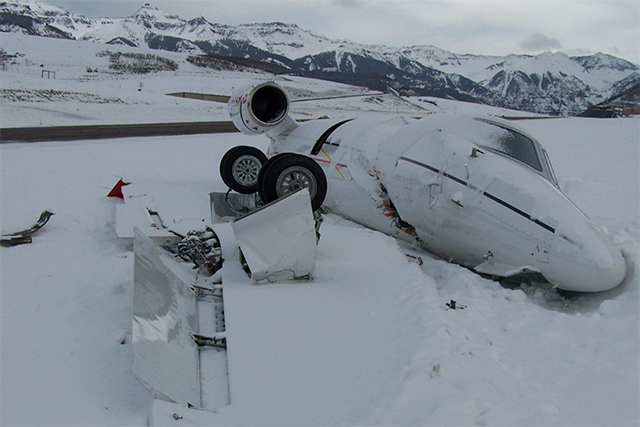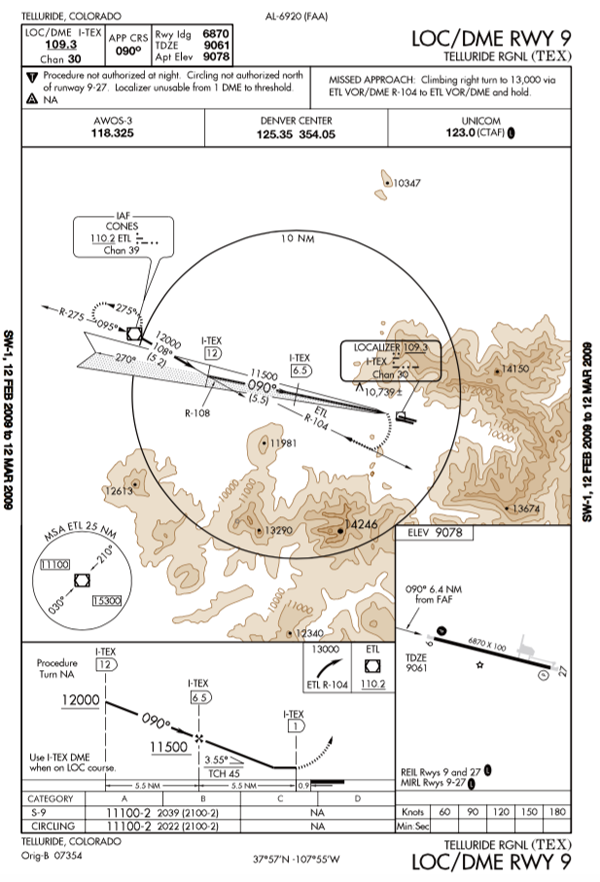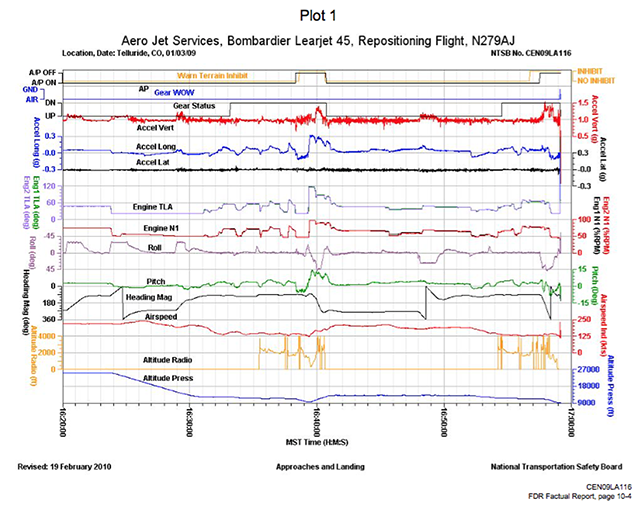The NTSB chalks this mishap up to both pilots failing to positively identify a snow-covered runway prior to landing but it involved so much more than that. Both pilots obviously had no problem flying a Category C aircraft on an approach where Category C minimums were not authorized. But after the first approach led to a missed approach, the PIC forcefully talked the SIC into an unplanned circling approach that could not have been flown in a stable manner and probably left them with inadequate time to positively identify the runway. It is doubtful the SIC, who was the pilot flying, ever really saw the runway.
— James Albright

Updated:
2015-09-25
How could this happen? Crew coordination was obviously a factor. The pilot flying (PF) was the Second in Command (SIC) and was junior in experience: 36 years old, 3,520 hours total, 831 hours in type. The pilot not flying (PNF) was the Pilot in Command (PIC) and was senior: 42 years old, 4,800 hours, 1,038 hours in type.
But perhaps even worse than the poor instrument procedures and flawed crew coordination there was a tragic lack of flight discipline.

1
Accident report
- Date: 3 January 2009
- Time: 1659
- Type: Learjet 45XR
- Operator: Aero Jet Services
- Registration: N279AJ
- Fatalities: 0 of 2 crew, 0 of 0 passengers
- Aircraft Fate: Destroyed
- Phase: Landing
- Airport (Departure): Scottsdale Airport, AZ (KSDL), United States of America
- Airport (Destination): Telluride Regional Airport, CO (KTEX), United States of America
2
Narrative
On January 3, 2009, at 1659 mountain standard time (MST) a Learjet 45XR, N279AJ, sustained substantial damage during an off-runway landing at Telluride Regional Airport (KTEX), Telluride, Colorado. The airplane was owned by LJ279, LLC, Missoula, Montana, and operated by Aero Jet Services, Scottsdale, Arizona. The airline transport pilot in the left seat was not injured and the airline transport pilot in the right sear received minor injuries. Intermittent visual meteorological conditions were present at the time of the accident and an instrument rules flight plan was filed for the Title 14 Code of Federal Regulations Part 91 positioning flight. The cross-country flight originated at the Scottsdale Airport (KSDL), Scottsdale, Arizona, at 1503.
Source: NTSB Aircraft Accident Narrative, CEN09LA116
Pilot Statements
- In a statement provided by the Pilot-In-Command (PIC), who was seated in the right seat, upon arrival at KTEX the weather was reported to be below minimums; the crew elected to hold over the CONES VOR and wait to see if weather conditions would improve. The crew was given instructions, by air traffic control, to hold as published and to expect further clearance (EFC) at 1630. When the weather improved to a visibility of 4 miles and a ceiling of 2,300 feet, the PIC requested a descent and approach to KTEX. The crew was unable to complete the first landing attempt and called for a missed approach back to the VOR. The pilot then requested a second attempt to land stating that "if we did not land, we would like to be sequenced to into KMTJ" (Montrose Regional Airport Montrose, Colorado), their alternate airport.
- On the second approach, both crew members stated that they had acquired the runway environment; however, they were still too high for a visual approach. The crew elected to do a 360-degree, right, descending turn, in order to be in a better position for landing. On completion of the turn, they again affirmed the runway environment and alignment with the extended centerline of the runway. The airplane touched down and after full thrust reversers were deployed, the nose gear collapsed. The airplane began to slide in snow and came to a stop in an upright position.
- In a statement provided by the pilot flying, at 4 nautical miles both pilots had the runway in sight. They were not in a position to make a normal descent to the runway so the PIC suggested a 360-degree turn. The pilot added that at the completion of the turn, she was aligned with the extended centerline. Additionally, the precision approach path indicator (PAPI) was to the left and the right side runway edge identifier lights were to the right of the intended flight path. During the round out, the pilot shifted her view to the end of the runway. Between the round-out to touchdown, the PIC was telling the pilot to get it down on the runway but at the same time she was correcting for an unexpected gust of wind from the left. She applied a correction to maintain runway centerline. As the main landing gear contacted the ground, the pilot felt that the landing was normal. When the nose gear entered the snow the pilot felt the airplane "roll." No unusual airplane and engine performance was mentioned in the pilot’s report.
Source: NTSB Aircraft Accident Narrative, CEN09LA116
Weather
- Observation 2330 Zulu (1630 local) was broadcasted prior to the crew beginning the first attempted approach. The observation reported winds from 260 at 4 knots, visibility 4 miles with light snow, scattered clouds at 300 feet, and an overcast ceiling at 1,700 feet.
- Prior to going missed approach on the first landing attempt, observation 2338 Zulu (1638) reporting winds from 250 at 5 knots, visibility 2.5 miles with light snow, scattered clouds at 400 feet, a broken ceiling at 1,300 feet, and an overcast ceiling at 1,800 feet.
- While conducting the second approach and prior to landing at KTEX, a partial AWOS excerpt reported a visibility of 4 miles with light snow, scattered clouds at 200 feet, a broken ceiling at 1,500 feet, and an overcast ceiling at 2,100 feet.
Source: NTSB Aircraft Accident Narrative, CEN09LA116
3
Analysis
- According to an excerpt from the CVR, the common traffic advisory frequency (CTAF) reported to the pilots that Telluride had "an inch and half of snow or so on the runway. We have not plowed it, we were waiting until tomorrow. We’re scattered at 300, overcast at 1,700 and heavy snow."
- A review of the Localizer/DME approach chart to runway 9 revealed that the approach is valid for category A and B aircraft; aircraft with reference landing speeds (Vref) lower than 121 knots. The circling and straight-in minimum descent altitudes are both 11,100 feet mean sea level. The weather required for both the circling and straight-in approaches were listed as 2,100 feet ceiling and 2 miles visibility.
Source: NTSB Aircraft Accident Narrative, CEN09LA116
The airspeed during the circle (bottom red line) was clearly around 125 knots, well above the Category B maximum speed for circling at sea level; making a circling approach for this airplane at this airport illegal. Their true airspeed at the approach MDA (11,100') would have been 152 knots; making the decision to circle even more foolhardy.
"It was not until the following night that Mike and I were informed that we had not landed on the runway. I am uncertain on how that came to be, both Mike and I had visually made contact with the definition on [sic] the runway. I can only guess that due to the crosswind that during the round out phase I lost visual references of the runway to cause the aircraft to drift undetected."
Source: NTSB Aircraft Accident Narrative, CEN09LA116, PF Statement
- HOT — Flight crew audio panel voice or sound source
- -1 — Voice identified as the PIC The PNF
- -2 — Voice identified as the SIC The PF
Source: NTSB Aircraft Accident Narrative, CEN09LA116, Cockpit Voice Recorder
The PNF (HOT-2) spotted the runway on the first attempt and tried to coach the PF to the runway but she never saw it and they went missed. During the second approach they had this exchange:
- 16:53:04 HOT-1 I don't know why they didn't plow it... kinda asinine.
- 16:53:04 HOT-2 assuming that no one's getting in. I don't know.
- 16:53:07 HOT-1 why wouldn't you still plow it... cause the snow's not supposed to last much longer anyway.
- 16:53:08 HOT-2 I don't know.
Source: NTSB Aircraft Accident Narrative, CEN09LA116, Cockpit Voice Recorder
On the second attempt they were at the MDA and had this exchange:
- 16:56:40 EGPWS minimums. minimums.
- 16:56:49 HOT-1 we ain't gonna make it. three miles from the runway and we're still two thousand feet above the runway.
- 16:56:56 HOT-2 #.
- 16:57:04 HOT-2 and the runway is the missed?
- 16:57:06 HOT-1 no one mile from and we're two uh one mile from that.
- 16:57:17 HOT-2 #.
- 16:57:20 HOT-1 oh #. naw there's the runway way down there. we'd have to circle down and go...
- 16:57:21 HOT-2 yea we're not gonna make that. #.
Source: NTSB Aircraft Accident Narrative, CEN09LA116, Cockpit Voice Recorder
The MDA was 2,039' above the runway; they would have needed to spot the runway at 6.4 nm to have a normal 3° glide path. The FAF was 500' higher than the MDA but only 6.5 nm from the end of the runway. A stable instrument approach was impossible from the FAF at the published FAF altitude. As is typical with many approaches in mountainous areas, you need to spot the runway well before the final approach fix. This should be part of the approach briefing, you don't want to find yourself at minimums approaching the missed approach point and having to figure this out.
- 16:57:23 HOT-1 I mean we could almost circle and do it. wanna try?
- 16:57:27 HOT-2 I don't.. [sound similar to sigh].
- 16:57:27 HOT-1 circle this way.
- 16:57:28 HOT-2 uuhhh...
- 16:57:29 HOT-1 try it.
Source: NTSB Aircraft Accident Narrative, CEN09LA116, Cockpit Voice Recorder
They did not brief a circling approach and a careful review of the approach plate would have revealed such a maneuver would be illegal for a Category C aircraft. The maximum circling approach area radii for a Category B aircraft under existing TERPS criteria would have been 1.5 nm.
More about this: Circling Approach Area.
At their existing true airspeed, their turn radius with 30° of bank would have been 5,500' making their turn diameter 11,000' or 1.81 nm. And this is based on rolling out on top of the runway without a stable approach. So the circling approach would have been impossible with less than 30° of bank, as we shall see . . .
- 16:57:31 HOT-2 [sound similar to manual disconnect of autopilot]
- 16:57:31 HOT-1 go this way. cut it in tight though. if you go back in the clouds we're going missed. cut it tight.
Source: NTSB Aircraft Accident Narrative, CEN09LA116, Cockpit Voice Recorder
The flight data recorder (shown above) indicates the bank angle reached 45° at several points.
- 16:57:45 HOT-2 I need to maintain that altitude.
- 16:57:47 HOT-1 ah don't no...you're gonna have to please.
- 16:57:50 HOT-2 what?
- 16:57:50 HOT-1 i think i think we're about to go back into the clouds.
- 16:57:52 HOT-2 oops.
Source: NTSB Aircraft Accident Narrative, CEN09LA116, Cockpit Voice Recorder
As they rolled out the PNF spotted the runway . . .
- 16:58:14 HOT-1 keep bringing it down keep it slow, slow, there's the runway right there.
- 16:58:19 HOT-2 ooh.
- 16:58:22 HOT-1 keep it slow. take the power out. see the lead in light ah the blinker.
- 16:58:30 HOT-2 no i don't see anything yet.
- 16:58:33 HOT-1 there's the runway.
- 16:58:34 HOT-2 oh # ... are you kidding me?
- 16:58:35 HOT-1 yea... you need you need to be down.
- 16:58:41 HOT-1 get ready for full thrust reverser.. middle's over here.
- 16:58:43 HOT-2 **
- 16:58:48 HOT-1 just put it down. put it down.
- 16:58:51 HOT-2 I'm trying. where is it?
Source: NTSB Aircraft Accident Narrative, CEN09LA116, Cockpit Voice Recorder
In her post accident statement, the PF said she spotted the runway prior to landing. It is evident here she did not see the runway while below the MDA.
- 16:58:53 HOT-1 put it down. it's right here.
- 16:58:54 EGPWS sink rate.
- 16:58:55 HOT-1 put it down.
- 16:58:56 EGPWS sink rate.
- 16:58:56 HOT-1 put it down.
- 16:58:57 HOT-2 i...
- 16:58:57 EGPWS fifty.
- 16:58:58 HOT-1 i know you don't want to listen to me.
- 16:58:58 EGPWS forty.
- 16:58:59 EGPWS sink rate.
- 16:59:00 HOT-1 put it down.
- 16:59:00 EGPWS twenty.
- 16:59:01 HOT-1 don't float it.
- 16:59:01 EGPWS sink rate.
- 16:59:02 HOT-1 put it down.
- 16:59:02 HOT-2 #.
- 16:59:03 EGPWS ten.
- 16:59:05 HOT-1 full thrust reverser.
- 16:59:06 CAM [sound similar to initial impact]
- 16:59:07 CAM overspeed [aircraft aural warning]
- 16:59:09 HOT-2 oh god...no no.
Source: NTSB Aircraft Accident Narrative, CEN09LA116, Cockpit Voice Recorder
An on-scene investigation was conducted by a Federal Aviation Administration (FAA) inspector. The initial examination of the area indicated that the airplane had touched down about 20-feet to the right, and off, the runway. Additionally, the airplane's wings were torn from the fuselage. The tail section had separated just aft of the engines. No pre-impact anomalies with the airframe and engines were detected during the investigation.
Source: NTSB Aircraft Accident Narrative, CEN09LA116
4
Cause
The failure of both pilots to positively identify the runway prior to landing.
Source: NTSB Aircraft Accident Docket, CEN09LA116, Probable Cause Statement
The airplane was destroyed; but it was a cheap airplane and nobody got seriously hurt so the NTSB didn't put a lot of effort into this investigation. They didn't issue a full report and the statement of probable cause was one sentence long. They could have done a lot better:
- The pilots failed to consider that the planned straight-in approach was not authorized for their approach category.
- The pilots failed to consider that the planned runway, which was uncleared of snow, would have been difficult to see under the best of conditions.
- The PIC failed to realize the unplanned circling approach, which had not been previously briefed, would have been impossible to complete using normal maneuvering bank angles or with enough final approach distance to permit a stabilized approach.
- The SIC failed to challenge the PIC's decision to commence an unplanned circling approach.
References
(Source material)
NTSB Aircraft Accident Docket, CEN09LA116
NTSB Aircraft Accident Narrative, CEN09LA116


